
Concept explainers
(a)
Interpretation: The product formed when the given compound in Problem 27.6 undergoes photochemical electrocyclic ring opening or ring closure is to be predicted. The given process is to be labeled as conrotatory or disrotatory. The stereochemistry around tetrahedral stereogenic centers and double bonds is to be indicated.
Concept introduction: Electrocyclic reactions involve the conversion of
Curved arrows aid in determining the movement and flow of electrons in the reaction. The electrons that take part in the
Answer to Problem 27.8P
The product formed in the given photochemical electrocyclic ring closure reaction is
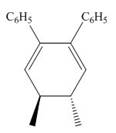
Explanation of Solution
The thermal electrocyclic ring closure reaction is shown below.
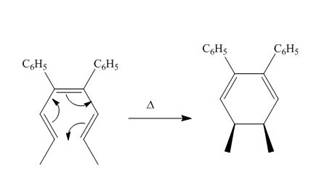
Figure 1
Electrocyclic reactions involve the conversion of
Under photochemical condition, conrotatory process takes place in the given reaction. The orientation of substituents and stereochemistry around tetrahedral stereogenic centers and double bonds in the given reaction are shown below.
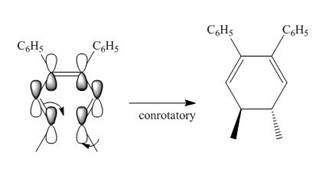
Figure 2
The conrotatory process involves the rotation of two orbitals in the same direction. The reaction in above figure implies that orbitals move in the same direction in the reactant molecule and the formation of trans product occurs. One methyl group is present above the plane and one methyl group is present below the plane in the product. Therefore, the product formed in the given photochemical electrocyclic ring closure reaction is
The product formed in the given photochemical electrocyclic ring closure reaction is
(b)
Interpretation: The product formed when the given compound in Problem 27.6 undergoes photochemical electrocyclic ring opening or ring closure is to be predicted. The given process is to be labeled as conrotatory or disrotatory. The stereochemistry around tetrahedral stereogenic centers and double bonds is to be indicated.
Concept introduction: Electrocyclic reactions involve the conversion of
Curved arrows aid in determining the movement and flow of electrons in the reaction. The electrons that take part in the chemical reactions are shown by the curved arrows.
Answer to Problem 27.8P
The product formed in the given photochemical electrocyclic ring opening reaction is

Explanation of Solution
The thermal electrocyclic ring opening reaction is shown below.
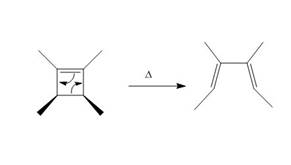
Figure 3
Electrocyclic reactions involve the conversion of
Under photochemical condition, disrotatory process takes place in the given reaction. The movement of substituents and stereochemistry around tetrahedral stereogenic centers and double bonds in the given reaction are shown below.
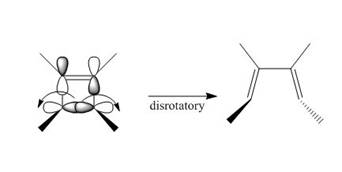
Figure 4
The disrotatory process involves the rotation of two orbitals in the opposite direction. The reaction in above figure implies that orbitals move in the opposite direction in the reactant molecule and the formation of trans product occurs. One methyl group is present above the plane and one methyl group is present below the plane in the product shows the stereochemistry. Therefore, the product formed in the given photochemical electrocyclic ring opening reaction is
The product formed in the given photochemical electrocyclic ring opening reaction is
Want to see more full solutions like this?
Chapter 27 Solutions
ORG.CHEMISTRY W/ACCESS+MODEL KIT PKG
- What stereoisomers are formed in the following reaction? Are they enantiomers or diastereomers? Which stereoisomer is formed in greater yield?arrow_forwardDraw the products formed when each alkene is treated with BH3 followed by H2O2,HO−. Include the stereochemistry at all stereogenic centers.arrow_forwardDraw the monochlorination products formed when each compound is heated with Cl2. Include the stereochemistry at any stereogenic center.arrow_forward
- Friedel–Crafts alkylation of benzene with (R)-2-chlorobutane and AlCl3 affords sec-butylbenzene. How many stereogenic centers are present in the product?arrow_forwardDraw the products formed when attached alkene is treated with BH3 followed by H2O2, HO−. Include the stereochemistry at all stereogenic centersarrow_forwardDraw the products of each reaction, and indicate the stereochemistry at all stereogenic centers.arrow_forward
 ChemistryChemistryISBN:9781305957404Author:Steven S. Zumdahl, Susan A. Zumdahl, Donald J. DeCostePublisher:Cengage Learning
ChemistryChemistryISBN:9781305957404Author:Steven S. Zumdahl, Susan A. Zumdahl, Donald J. DeCostePublisher:Cengage Learning ChemistryChemistryISBN:9781259911156Author:Raymond Chang Dr., Jason Overby ProfessorPublisher:McGraw-Hill Education
ChemistryChemistryISBN:9781259911156Author:Raymond Chang Dr., Jason Overby ProfessorPublisher:McGraw-Hill Education Principles of Instrumental AnalysisChemistryISBN:9781305577213Author:Douglas A. Skoog, F. James Holler, Stanley R. CrouchPublisher:Cengage Learning
Principles of Instrumental AnalysisChemistryISBN:9781305577213Author:Douglas A. Skoog, F. James Holler, Stanley R. CrouchPublisher:Cengage Learning Organic ChemistryChemistryISBN:9780078021558Author:Janice Gorzynski Smith Dr.Publisher:McGraw-Hill Education
Organic ChemistryChemistryISBN:9780078021558Author:Janice Gorzynski Smith Dr.Publisher:McGraw-Hill Education Chemistry: Principles and ReactionsChemistryISBN:9781305079373Author:William L. Masterton, Cecile N. HurleyPublisher:Cengage Learning
Chemistry: Principles and ReactionsChemistryISBN:9781305079373Author:William L. Masterton, Cecile N. HurleyPublisher:Cengage Learning Elementary Principles of Chemical Processes, Bind...ChemistryISBN:9781118431221Author:Richard M. Felder, Ronald W. Rousseau, Lisa G. BullardPublisher:WILEY
Elementary Principles of Chemical Processes, Bind...ChemistryISBN:9781118431221Author:Richard M. Felder, Ronald W. Rousseau, Lisa G. BullardPublisher:WILEY





